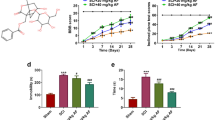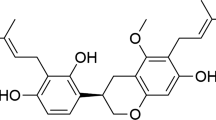Abstract
Background
Kaempferol (KMF) is a flavone reported to have anti-oxidant and anti-inflammatory activity.
Objective
The present study screened the effect of KMF in the animal model of spinal cord injury (SCI).
Results
KMF caused a significant inhibition of spinal cord injury mediated oxidative stress and also suppressed the inflammatory reactions. The treatment of KMF also inhibited the levels of p53, TGF-β1 and COX-2 whereas a significant elevation in Bcl-2/Bax ratio was observed after the rats were treated with KMF. The in silico docking analysis suggested potential binding of KMF having lower energy with p53 confirming the potential target of KMF.
Conclusion
The treatment of KMF exerted neuroprotective effect by improving the anti-oxidant status and inflammatory response. The significant spinal cord injury protective effect of KMF in rats was attributed by targeting p53 and Bcl-2/Bax ratio.







Similar content being viewed by others
References
Ahuja CS, Martin AR, Fehlings M (2016) Recent advances in managing a spinal cord injury secondary to trauma. F1000Res 5:1017
Al-Numair KS, Chandramohan G, Veeramani C, Alsaif MA (2015) Ameliorative effect of kaempferol, a flavonoid, on oxidative stress in streptozotocin-induced diabetic rats. Redox Rep 20(5):198–209
Arif H, Sohail A, Farhan M, Rehman AA, Ahmad A, Hadi SM (2018) Flavonoids-induced redox cycling of copper ions leads to generation of reactive oxygen species: a potential role in cancer chemoprevention. Int J BiolMacromol 106:569–578
Bian Y, Liu P, Zhong J, Hu Y, Fan Y, Zhuang S, Liu Z (2019) Kaempferol inhibits multiple pathways involved in the secretion of inflammatory mediators from LPS-induced rat intestinal microvascular endothelial cells. Molecular Med Rep 19(3):1958–1964
Boots AW, Haenen GR, Bast A (2008) Health effects of quercetin: from antioxidant to nutraceutical. Eur J Pharmacol 585(2–3):325–337
Brown DA, Sawchenko PE (2007) Time course and distribution of inflammatory and neurodegenerative events suggest structural bases for the pathogenesis of experimental autoimmune encephalomyelitis. J Comp Neurol 502(2):236–260
Calderón-Montaño JM, Burgos-Morón E, Pérez-Guerrero C, López-Lázaro M (2011) A review on the dietary flavonoid kaempferol. Mini Rev Med Chem 11(4):298–344
Due MR, Park J, Zheng L, Walls M, Allette YM, White FA, Shi R (2014) Acrolein involvement in sensory and behavioral hypersensitivity following spinal cord injury in the rat. J Neurochem 128(5):776–786
Duetzmann S, Forsey LM, Senft C, Seifert V, Ratliff J, Park J (2015) Sacral peak pressure in healthy volunteers and patients with spinal cord injury: with and without liquid-based pad. Nurs Res 64:300–305
Dulin JN, Karoly ED, Wang Y, Strobel HW, Grill RJ (2013) Licofelone modulates neuroinflammation and attenuates mechanical hypersensitivity in the chronic phase of spinal cord injury. J Neurosci 33(2):652–664
Fu J, Fan HB, Guo Z, Wang Z, Li XD, Li J, Pei GX (2014) Salvianolic acid B attenuates spinal cord ischemia-reperfusion-induced neuronal injury and oxidative stress by activating the extracellular signal-regulated kinase pathway in rats. J Surg Res 188(1):222–230
He T, Wang Y, Xiang J, Zhang H (2014) In vivo tracking of novel SPIO-Molday ION rhodamine-BTM-labeled human bone marrow-derived mesenchymal stem cells after lentivirus- mediated COX-2 silencing: a preliminary study. Curr Gene Ther 14(2):136–145
Hurlbert RJ, Hadley MN, Walters BC, Aarabi B, Dhall SS, Gelb DE, Rozzelle CJ, Ryken TC, Theodore N (2015) Pharmacological therapy for acute spinal cord injury. Neurosurgery 76(Suppl 1):S71–S83
Kim HL, Ra H, Kim KR, Lee JM, Im H, Kim YH (2015) Poly(ADP-ribosyl)ation of p53 contributes to TPEN-induced neuronal apoptosis. Mol Cells 38(4):312–317
Kocic B, Kitic D, Brankovic S (2013) Dietary flavonoid intake and colorectal cancer risk: evidence from human population studies. Journal of BUON 18(1):34–43
Kotipatruni RR, Dasari VR, Veeravalli KK, Dinh DH, Fassett D, Rao JS (2011) p53- and Bax-mediated apoptosis in injured rat spinal cord. Neurochem Res 36(11):2063–2074
Kubota K, Saiwai H, Kumamaru H, Maeda T, Ohkawa Y, Aratani Y, Nagano T, Iwamoto Y, Okada S (2012) Myeloperoxidase exacerbates secondary injury by generating highly reactive oxygen species and mediating neutrophil recruitment in experimental spinal cord injury. Spine 37(16):1363–1369
Lee IN, Cheng WC, Chung CY, Lee MH, Lin MH, Kuo CH, Weng HH, Yang JT (2015) Dexamethasone reduces brain cell apoptosis and inhibits inflammatory response in rats with intracerebralhemorrhage. J Neurosci Res 93(1):178–188
Li F, Zhang B, Chen G, Fu X (2017) The novel contributors of anti-diabetic potential in mulberry polyphenols revealed by UHPLC-HR-ESI-TOF-MS/MS. Food Res Int (Ottawa, Ont) 100(Pt 1):873–884
Liebscher T, Niedeggen A, Estel B, Seidl RO (2015) Airway complications in traumatic lower cervical spinal cord injury: a retrospective study. J Spinal Cord Med 38:607–614
Liu J, Sun K, Zheng C, Chen X, Zhang W, Wang Z, Shar PA, Xiao W, Wang Y (2015) Pathway as a pharmacological target for herbal medicines: an investigation from reduning injection. PLoS One 10(4):e0123109
Luo Y, Fu C, Wang Z, Zhang Z, Wang H, Liu Y (2015) Mangiferin attenuates contusive spinal cord injury in rats through the regulation of oxidative stress, inflammation and the Bcl-2 and Bax pathway. Mol Med Rep 12:7132–7138
Manach C, Williamson G, Morand C, Scalbert A, Rémésy C (2005) Bioavailability and bioefficacy of polyphenols in humans. I. Review of 97 bioavailability studies. Am J ClinNutr 81(1 Suppl):230S-242S
Nascimento AM, Maria-Ferreira D, Dal Lin FT, Kimura A, de Santana-Filho AP, Werner M, Iacomini M, Sassaki GL, Cipriani TR, de Souza LM (2017) Phytochemical analysis and anti-inflammatory evaluation of compounds from an aqueous extract of Croton cajucaraBenth. J Pharm Biomed Anal 145:821–830
Navrkalova V, Sebejova L, Zemanova J, Jaskova Z, Trbusek M (2013) The p53 pathway induction is not primarily dependent on Ataxia Telangiectasia Mutated (ATM) gene activity after fludarabine treatment in chronic lymphocytic leukemia cells. Leuk Lymphoma 54(8):1840–1843
Oliveira EJ, Watson DG, Grant MH (2002) Metabolism of quercetin and kaempferol by rat hepatocytes and the identification of flavonoid glycosides in human plasma. Xenobiotica 32(4):279–287
Pei J, Chen A, Zhao L, Cao F, Ding G, Xiao W (2017) One-pot synthesis of hyperoside by a three-enzyme cascade using a UDP-galactose regeneration system. J Agric Food Chem 65(29):6042–6048
Siddiq A, Aminova LR, Troy CM, Suh K, Messer Z, Semenza GL, Ratan RR (2009) Selective inhibition of hypoxia-inducible factor (HIF) prolyl-hydroxylase 1 mediates neuroprotection against normoxic oxidative death via HIF- and CREB-independent pathways. J Neurosci 29(27):8828–8838
Silva NA, Sousa N, Reis RL, Salgado AJ (2014) From basics to clinical: a comprehensive review on spinal cord injury. ProgNeurobiol 114:25–57
Suberviola B, González-Castro A, Llorca J, Ortiz-Melón F, Miñambres E (2008) Early complications of high-dose methylprednisolone in acute spinal cord injury patients. Injury 39(7):748–752
Suchal K, Malik S, Khan SI, Malhotra RK, Goyal SN, Bhatia J, Ojha S, Arya DS (2017) Molecular pathways involved in the Amelioration of myocardial injury in diabetic rats by Kaempferol. Int J MolSci 18(5):1001
Suwanna N, Thangnipon W, Kumar S, de Vellis J (2014) Neuroprotection by diarylpropionitrile in mice with spinal cord injury. Excli J 13:1097–1103
Uckermann O, Galli R, Beiermeister R, Sitoci-Ficici KH, Later R, Leipnitz E, Neuwirth A, Chavakis T, Koch E, Schackert G (2015) Endogenous two-photon excited fluorescence provides label-free visualization of the inflammatory response in the rodent spinal cord. Biomed Res Int 2015:859084
Wang L, Tu YC, Lian TW, Hung JT, Yen JH, Wu MJ (2006) Distinctive antioxidant and antiinflammatory effects of flavonols. J Agric Food Chem 54(26):9798–9804
Wang W, Shen H, Xie JJ, Ling J, Lu H (2015) Neuroprotective effect of ginseng against spinal cord injury induced oxidative stress and inflammatory responses. Int J ClinExp Med 8(3):3514–3521
Wang J, Fang X, Ge L, Cao F, Zhao L, Wang Z, Xiao W (2018) Antitumor, antioxidant and anti-inflammatory activities of kaempferol and its corresponding glycosides and the enzymatic preparation of kaempferol. PLoS One 13(5):e0197563
Wu Y, Sun J, George J, Ye H, Cui Z, Li Z, Liu Q, Zhang Y, Ge D, Liu Y (2016) Study of neuroprotective function of Ginkgo biloba extract (EGb761) derived-flavonoid monomers using a three-dimensional stem cell-derived neural model. BiotechnolProg 32(3):735–744
Yoon DS, Yoo JH, Kim YH, Paik S, Han CD, Lee JW (2010) The effects of COX-2 inhibitor during osteogenic differentiation of bone marrow-derived human mesenchymal stem cells. Stem Cells Develop 19(10):1523–1533
Zani A, Cananzi M, Fascetti-Leon F, Lauriti G, Smith VV, Bollini S, Ghionzoli M, D’Arrigo A, Pozzobon M, Piccoli M, Hicks A, Wells J, Siow B, Sebire NJ, Bishop C, Leon A, Atala A, Lythgoe MF, Pierro A, Eaton S, De Coppi P (2014) Amniotic fluid stem cells improve survival and enhance repair of damaged intestine in necrotising enterocolitis via a COX-2 dependent mechanism. Gut 63(2):300–309
Zhang P, Hölscher C, Ma X (2017) Therapeutic potential of flavonoids in spinal cord injury. Rev Neurosci 28(1):87–101
Acknowledgement
The authors very much thankful to the staff and management of The Second Affiliated Hospital of Nanchang University.
Author information
Authors and Affiliations
Contributions
All the authors contributed equally in preparing the manuscript. LC and KC planned the study. YG, CL, WM, WZ, JZ, HZ along with LC and KC performed the experiments and formatted the data. All the authors contributed to preparing the manuscript and reviewed the paper before submitting.
Corresponding author
Ethics declarations
Conflict of interest
Lu Chen, Kai Cao, Yurong Gu, Chao Luo, Wei Mao, Weijun Zhou, Jinwei Zhu, Huying Zhang authors have no conflict of interest.
Ethical approval
The animal studies were approved by the ethical review board of The Second Affiliated Hospital of Nanchang University, Nanchang, Jiangxi, China, the approval number for the study was S0144C.
Additional information
Publisher's Note
Springer Nature remains neutral with regard to jurisdictional claims in published maps and institutional affiliations.
Rights and permissions
About this article
Cite this article
Chen, L., Cao, K., Gu, Y. et al. Kaempferol attenuates spinal cord injury by interfering inflammatory and oxidative stress by targeting the p53 protein: a molecular docking analysis. Mol. Cell. Toxicol. 17, 257–266 (2021). https://doi.org/10.1007/s13273-021-00132-x
Accepted:
Published:
Issue Date:
DOI: https://doi.org/10.1007/s13273-021-00132-x




